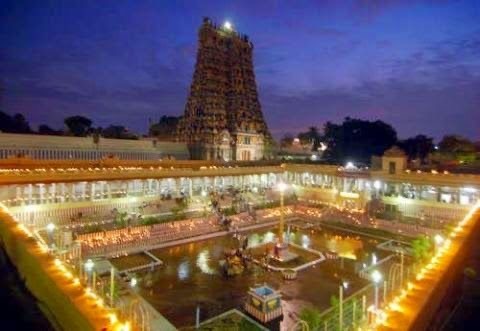
Arulmigu Meenakshi Amman Temple Madurai, Tamil Nadu
While I read and have known about #Meenakshi Temple for decades, it took long to write as there is so much beauty which words may not justify totally. However have attempted my bit about this Temple visited by crores of devotees each year.
Arulmigu #Meenakshi Amman #Temple is located in #Madurai, Tamil Nadu covering an area of approx. 45 acres. It is on the southern bank of Vaigai river. It has historical, religious as well as architectural significance
Temple is dedicated to Goddess Meenakshi known to be a form of Maa Parvati and Lord #Sundareshwara, known to be a form of Lord Shiva. The Temple was built around 2500 years ago by Pandayan Emperor Sadayavarman Kulasekaran.
He built three storey Gopura (large pyramidal tower) at the entrance of Sundareswarar Shrine & The central portion of Goddess Meenakshi Shrine, He also built Shrine for Lord Natrajar & Lord Surya near the main Temple, Lord Ayyanar in the east, Lord Vinayagar (Ganesha) in the south, Lord Kariamalperumal (Vishnu) in the west and Maa Kali in the north.
However most of the Temple’s current structure was rebuilt after 14th century AC, further repaired, renovated and expanded 16th century onwards by Tirumala Nayakar. The Nayaka rulers followed the Hindu texts on architecture called the Shilpa Shastras in redesigning the temple city plan and the Meenakshi temple. Shlipa Shastras is ancient umbrella term for numerous Hindu texts that describe arts, crafts, and their design rules, principles and standards.
The Temple now has 14 Gopurams, each ranging in height from 45 – 50 meters. Out of the these the huge ones are in the 4 main directions out of which the tallest is the Southern tower which is of height 51.9 meters (170 feet). Their soaring towers rise from solid granite bases, and are covered with stucco figures of Deities, mythical animals and monsters painted in vivid colours. The outer towers are the landmarks of Madurai. In one of the renovations 2 Gopurams of the main shrine were plated with gold.
The complex has numerous sculpted pillared halls out of which most known is Aayiram Kaal Mandapam (1000-pillared hall pic attached) is a spectacular architectural piece where each pillar is believed to have been carved with various sculptures. The temple is known to have 33000 sculptures.
Just outside this mandapam, towards the west, are the Musical Pillars. Each pillar when stuck produces a different musical note. The Kalyana Mandapa, to the south of the pillared hall, is where the marriage of Shiva and Parvati is celebrated every year during the Chitirai Festival in mid April.
The Oonjal Mandapam or swing hall and the Killikoontu or parrot cage hall are on the western side of the tank. Every Friday, the golden idols of Meenakshi and Sundareswarar are seated and hymns are sung as the deities gaily swing to and fro. The parrots in the Kilikoontu Mandapam have been trained to repeat Meenakshi's name. There are interesting 28 pillars which exhibit excellent sculptures of figures from Hindu mythology.
This ancient Temple is mentioned first in 6th century CE in Tamil Sangam literature. An ancient Golden Lotus Tank called Potramaraikulam, was the meeting place of the Tamil Sangam, the ancient academy of poets. The tank is surrounded by a pillared corridor. It has golden hued lotus flowers.
Thank you for reading this patiently.
Waiting for my calling to be blessed in this beautiful Temple soon.
Thank you Maa Kaushliya Pariyani & BabaSai.
Data Source - Internet